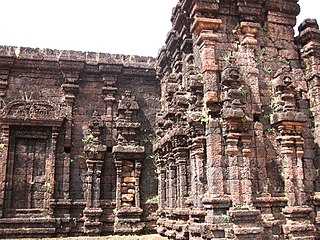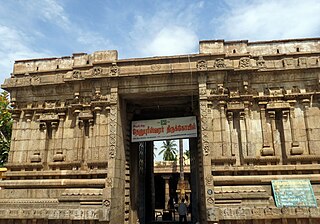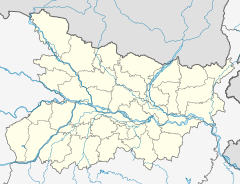
Venkateswara, also known by various other names, is a form of the Hindu god Vishnu. Venkateswara is the presiding deity of the Tirumala Venkateswara Temple, located in Tirupati, Sri Balaji District, Andhra Pradesh, India.

Babulnath Mandir is an ancient Shiva mandir in Mumbai, India. Situated on a small hillock near Girgaum Chowpatty, it is one of oldest mandirs in the city, Shiva in the form of the Lord of the Babul tree is the main deity in this temple. The faithful climb up to the mandir and obtain Darshan of the shivling and obtain blessings of the Lord. It is also possible to take an elevator up to the temple. The temples is visited by lakhs of devotees on annual Mahashivratri festival.

Gupteswar Cave is a cave shrine dedicated to Shiva. It is a pilgrim site situated about 55 km (34 mi) away Jeypore, Koraput District in the state of Odisha, India. It is a limestone cave, and its main attraction is the gigantic Shiva Linga which is said to be increasing in size. It is believed that the cave was discovered by Rama and re-discovered in the reign of Maharajah Veer Vikram Dev. In the holy month of Shravan, the cave is visited by devotees who walk to the shrine bare-footed with decorated bamboo palanquins called "Kanwadiya" and bathe in the maha kund before worshipping Lord Gupteshwar. There are 200 steps to reach to the Shiva linga temple. Its entrance is about 3 metres (9.8 ft) wide and 2 metres (6.6 ft) high.

The Khatu Shyam Temple is a Hindu temple in Khatoo village of Sikar district in Rajasthan, India. It is a pilgrimage site for worshipping the deity Krishna and Barbarika who is often venerated as a Kuladevata. Devotees believe the temple houses the head of Barbarika or Khatushyam, a legendary warrior who sacrifices his head upon the request of Krishna during the antebellum of the Kurukshetra War.

The Rajarajeshwara temple is a Shiva temple located in Taliparamba in Kannur district of Kerala, India. The temple is regarded as one of the existing 108 ancient Shiva Temples of ancient Kerala. It also has a prominent place amongst the numerous Shiva temples in South India. It had the tallest shikhara amongst the temples of its time. The Rajarajeshwara temple has a top of about 90 tonnes. If any problem is encountered in the other temples of South India, devotees seek a solution in this temple through a prashnam, a traditional method of astrological decision-making. The prashnam is conducted on a peedha outside the temple.

Changu Narayan is an ancient Hindu temple, located on a high hilltop that is also known as Changu or Dolagiri in Changunarayan Municipality of Bhaktapur District, Nepal. This hill is about 7 miles east of Kathmandu and a few miles north of Bhaktapur. The Manohara River flows beside the hill. The temple is considered to be one of the oldest temple in Nepal. The temple is dedicated to lord Vishnu and is held in special reverence by the Hindu people.

Sangameswarar temple is a temple in Bhavani, in the Erode district, of the Indian state of Tamil Nadu. It is a Hindu temple dedicated to Lord Shiva. It is 15 km from Erode, 30 km from Gobichettipalayam, 56 km from Salem and 106 km from Coimbatore.

Pashupatinath Temple is a Hindu temple dedicated to Lord Shiva, and is located in Kathmandu, Nepal near the sacred Bagmati River.

Chandesha or Canda or Chandikeshwara is one of the 63 Nayanars. Processional bronze images of him generally show him as a boy, with entwined locks of hair, standing with his hands in Añjali Mudrā and with an axe in the crook of his arm. In the Shaiva temples of South India, his shrine is positioned within the first enclosure wall of the temple complex and to the North East of the lingam. He is there typically shown seated, with one leg dangling downwards, a hand on one thigh and an axe clasped in the other. He faces inwards towards the main temple wall. He is depicted as deeply lost in meditation, and devotees snap their fingers or clap their hands to attract his attention. Another explanation, since he is considered to be the guardian of the temple belongings, is that devotees clap their hands to show that they are leaving the temple empty-handed. It is also customary to leave even the sacred ash inside the temple itself.
Singheshwar is one of the administrative divisions of Madhepura district in the Indian state of Bihar. The block headquarters are located at a distance of 6 km from the district headquarters, namely, Madhepura. There's a temple of Lord Shiva. Devotees come from many places for puja. In month of Saavan Singheshwar is jam packed by people. People from Nepal also come for puja.
Chinnamanur is a town and a municipality in Theni district in the state of Tamil Nadu, India. As of 2011, the town had a population of 42,305. The town is one of the major trade centers in the district and supports basic needs for a population of more than 1,00,000 people in and around the town. Chinnamanur in recent times is known for banana marketing. Processed banana from more than twenty units in Chinnamanur are exported to various countries. Chinnamanur also holds the most jewel shops in the entire Theni district. Chinnamanur is the fourth largest town in the district by population and second largest town in the district by area.

Sikkal Singara Velar Temple is one of the most popular Hindu temples dedicated to Lord Muruga and a contender for the unofficial seventh Padaiveedu of Muruga, along with the popular Arupadaiveedu.
For one of the major Hindu denominations, the Tirumala Sri Venkateswara Temple at Tirupati in the Indian state of Andhra Pradesh is the most famous Vaishnavite temple in the world. The presiding deity of Vishnu here is referred to as Venkateswara. There are many legends regarding this temple. Sri Venkatachala Mahatyam is the most accepted legend among these, which provides the history of the temple across the various yugas. This place had also been mentioned in many puranas. It has been said as "Venkatadri samasthanam Brahmande nasti kinchana, Venkatesha samodevo na bhuto na bhavishyati" which literally translates as There is no place in the entire Universe which is equal to Tirumala and there is no other God equal to Venkatesha in the past, present or will be in the future.
Bettadapura is a town located in Mysore district, in the Indian state of Karnataka. The name is derived from two Kannada words, "Betta" and "pura". Betta means "hill" and pura means "town".

The Sree Vaikom Mahadeva Temple is a temple dedicated to the Hindu god Shiva in Vaikom, Kerala, India. The temple, along with the Ettumanoor Shiva Temple and the Kaduthuruthy Shiva Temple is considered a powerful place of Shiva. The belief is that if a devotee worships all the three temples before the Ucha puja, all his/her wishes are fulfilled.

Umarkot Shiv Mandir, also known as Amarkot Shiv Mandir, is a Hindu temple situated in Umerkot District, near Rana Jaageer Goth, in Sindh Province of Pakistan. This temple is perhaps the oldest in Sindh. The temple is one of the most sacred Hindu place of worship in the Sindh

Pasupatiswarar Temple is located in Pandanallur in the Thiruvidaimarudur taluk of Thanjavur district in the South Indian state of Tamil Nadu. Shiva is worshiped as Pasupatheeswarar, and is represented by the lingam and his consort Parvati is depicted as Mangalambika. The presiding deity is revered in the 7th century Tamil Saiva canonical work, the Tevaram, written by Tamil poet saints known as the nayanars and classified as Paadal Petra Sthalam.
Spatika Lingam or Crystal Lingamor Crystal Shivling is a type of Lingam made from quartz. Spatika Lingam is called sphatika Sivalingam (Kannada -ಸ್ಪಟಿಕ ಲಿಂಗ),, . Sphatikam in Sanskrit means "made of crystal, crystalline", referring to quartz and alum.

Dhenupureeswarar Temple, is located in Madambakkam near Tambaram, Chennai. Dhenupureeswarar is the local name for the Hindu deity Shiva.
Kungiliya Kalaya Nayanar, also known as Kungiliya Kalaya, Kalayar, Kunguliya and Kalaya Nayanar, is a Nayanar saint, venerated in the Hindu sect of Shaivism. He is generally counted as the eleventh in the list of 63 Nayanars.














